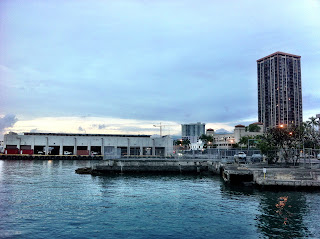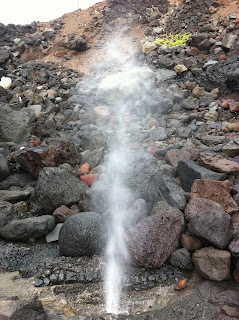This upright stone in the museum was from Nuuanu. I wanted to point this out because as mentioned in a earlier post, the Afong family lived near the intersection on Nuuanu Ave. and School St. Julia Fayerweather was listed in Bishop Museum's records as donating a pohaku found on their property from the soil of an old Lo'i that once surrounded that area in the old village of Kou. Could this be the Afong Pohaku?
Tuesday, March 26, 2013
Saturday, March 23, 2013
Honolulu Fort (Kekuanohu)
The following three black and white images are courtesy of Hawaii State Archives
Honolulu Fort dubbed Kekuanohu (the back of the scorpion fish) for it's gun placements and defense of Honolulu Harbor, started out as a trading post for Russian fur traders that stopped over to Hawaii for supplies. The Russians ended up abusing their privileges and began construction of a Fort on the shore of the harbor after King Kamehameha granted them the ability to only build a simple store house. It is said that they even used stones from a nearby Heiau, Pakaka. Once King Kamehameha learnt of this, he sent his advisor John Young and Kalanimoku along with a few more chiefs to expel the Russians off of the property. The Russians led by Georg Anton Schaffer even ended up leaving Oahu. As the King of Kauai, Kaumuaili'i had favored Russian sentiment over American interests. The Russians received land in Kauai and built a fort there instead.
I must note that Pakaka Heiau was where negotiations between Kaumuali'i and Kamehameha commenced. Which in turn finalized the unification of the Hawaiian islands into one Kingdom. As agreed by both parties that Kaumuali'i would relinquish Kauai to Kamehameha after he passed. Not soon enough though as a botched assassination on Kamuali'i was foiled by the honorable Isaac Davis, Kamehameha's other "haole" advisor and friend. As Isaac warned Kaumuali'i that his life was in danger and he should return to his island immediately. Sadly, the poison meant for Kaumuali'i was somehow digested by Isaac Davis. Eventually killing him and bringing much grief to Kamehameha.
Russian map from the early 1800's showing the fort
I found this model of old Honolulu in Aliiolani Hale with it's depiction of the fort on the shore of the bay.
What remains of the fort. Or at the very least, stones from the fort that were used to bring out the shore to more modern standards of a growing city. The harbor itself being dredged to accommodate larger ships. Thus creating the present shoreline of Honolulu and bolstering the immigration island, now known as Sand Island. Some cannons pictured in previous posts undoubtedly were placed in the fort.

The building on the right nearby the fort location was the home of Paul Marin. Another, lesser known advisor to Kamehameha the Great. He was gifted land after the Maui ruled, Oahu dynasty fell to Kamehameha. Marin also owned land in my home town and Ahupuaa of Waimalu. A Spaniard, Marin is accredited with introducing the islands to such crops as pineapple, cotton, mango, and grapes. He made brandy, experimented with beers, and may have been the brewer of a longtime favorite of Hawaii's very own
The Honolulu Fort was the foundation for the growth of a city, a kingdom, a state on the worlds stage. The next time you walk the streets of Honolulu remember what Fort St. led to.
Thursday, March 21, 2013
Oahu Reflections
Today marks the day that I am finally tapped out of images I could pull out of my library. from places I have visited in the past before starting this blog. Future posts will be places I have recently visited or revisited. That said, lets have one last blast as I touch briefly on a few more spots.
Paepae O He'eia
An Ahu recreated mauka He'eia
Waterfall on the way to Ka'au Crater
Tent home in a cave on Lahilahi Point.
H3 Freeway as viewed from Aiea Loop Trail
Back of Moanalua Valley
Pohaku Pa'akiki in Waimanalo
Healing with warm Noni on my swollen elbow
The Royal Hawaiian Band performing on the Iolani Palace grounds
Under a tree in Moanalua Gardens
What looks like a burial mound in Manoa near Kuka'o'o Heiau but not in the Castle Home property.
Pu'u Omao Pa Ilina hawaiian cemetary in Moanalua behind Senetor Sakamoto's home.
I will do a section on this hill in the future as it alludes to the "house of bones" in the old stories of this district.
A private pier in Maunalua Bay
Burmeister Overpass in Kalihi Valley over LikeLike Hwy.
The remains of the Diving pole that was set up at Allen Davis or Pele's Chair Beach.
West side blow hole on the path to Kaena Point from Yokohama Bay
Could I call this the Yee aumakua? It's my late grandfather's in Kapahulu. No one knows where he got it from. Now it sits in my Uncle's backyard just a few streets down from my grandpa's.
The historic first lychee tree in Hawaii brought here by Chun Afong. A self made millionaire during the time of the Hawaiian Monarchy. He lived here with his wife Julia Fayerweather and their 16 children, all pinnacles in history! House bill HR218 set up preservation over this tree and another one on the Nuuanu Shopping Plaza property. Lion's Cafe and now the relocated Radio Shack had to build around it.
Lemi Spring Memorial in "Happy Dog Park" Moanalua Gardens. The spring, now covered by the freeway, fed Moanalua's vast Lo'i.
Tuesday, March 19, 2013
Museum Monday (oh no it's Tuesday again!)
The "Piko" Stone is said to have been used for placing umbilical cords of newborns in the holes of this rock. It was found in Mililani and is similar to the holes found in the Oahu Nui stone in Waikakalaua Gulch. As well as another one pointed out to me in Kipapa Gulch by a colleague of mine. All being relatively in the same area. Did they have another purpose?
Monday, March 18, 2013
Waipahu
As mentioned in an earlier post, Waipahu is not an Ahupua'a. It is named after an area in Waikele where a gushing spring was located and made famous after the mill nearby used the name for this entire area. I visited this place today and so I will use this title.
Hawaii's Plantation Village is located off of the S-turn on Waipahu St. Along side of the Waikele stream and below the flow of the famous spring that brought prosper to this area for farming as it is still being used for on a smaller scale today.
Waikele stream begins to widen here and it is said that the Pu'uloa (Pearl Harbor) guardian and shark goddess Kaahupahau would swim up here to be fed Awa by worshippers.
Another legend about this area is that an Anvil for pounding tapa rolled down the stream from far up north and was returned through two women's friendship. Also that on the nearby hill where the mill stood was a Heiau named Hapupu where the Moku of Oahu living in Waikiki came with many followers to seize the land of his brother by having him killed by many people sneaking into his living area with stones disguised as pa'i'ai poi offerings and hurling them at his enclosure. Another Heiau called Mokoula was also nearby.
An earlier post titled Waikele with petroglyphs on the Pohaku Pili is located right across the street and at the end of that post we cross a bridge at the mouth of Waikele stream. In fact the Oahu Nui post yesterday is located in this stream where it is but a small trickle most of the year and called Waikakalaua Stream as it goes higher up north.
After talking to the local volunteers, they had no old mo'olelo to tell me besides some funny stories about growing up in Hawaii and staying married after many years. Which was of no less value. I would suggest visiting here on a Monday at around lunch because one of the Aunties there brings food to share with everyone that isn't shame enough to accept. They did hint about some spirits that are near the stream and some near the restored plantation homes. A hint to finding old dwellings of the late royalty of the island is to look for very tall royal palms. One here is the tallest I have ever seen before and five more here were also said to have been here before the modern village was constructed.
Hawaii's Plantation Village is located off of the S-turn on Waipahu St. Along side of the Waikele stream and below the flow of the famous spring that brought prosper to this area for farming as it is still being used for on a smaller scale today.
Waikele stream begins to widen here and it is said that the Pu'uloa (Pearl Harbor) guardian and shark goddess Kaahupahau would swim up here to be fed Awa by worshippers.
Another legend about this area is that an Anvil for pounding tapa rolled down the stream from far up north and was returned through two women's friendship. Also that on the nearby hill where the mill stood was a Heiau named Hapupu where the Moku of Oahu living in Waikiki came with many followers to seize the land of his brother by having him killed by many people sneaking into his living area with stones disguised as pa'i'ai poi offerings and hurling them at his enclosure. Another Heiau called Mokoula was also nearby.
An earlier post titled Waikele with petroglyphs on the Pohaku Pili is located right across the street and at the end of that post we cross a bridge at the mouth of Waikele stream. In fact the Oahu Nui post yesterday is located in this stream where it is but a small trickle most of the year and called Waikakalaua Stream as it goes higher up north.
After talking to the local volunteers, they had no old mo'olelo to tell me besides some funny stories about growing up in Hawaii and staying married after many years. Which was of no less value. I would suggest visiting here on a Monday at around lunch because one of the Aunties there brings food to share with everyone that isn't shame enough to accept. They did hint about some spirits that are near the stream and some near the restored plantation homes. A hint to finding old dwellings of the late royalty of the island is to look for very tall royal palms. One here is the tallest I have ever seen before and five more here were also said to have been here before the modern village was constructed.
Subscribe to:
Comments (Atom)

























































